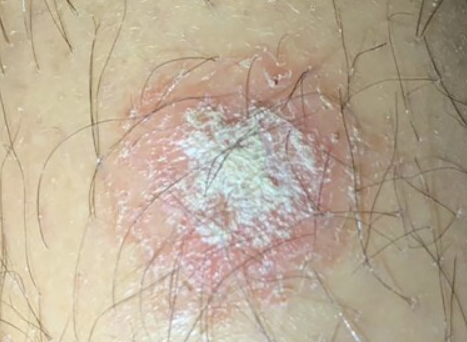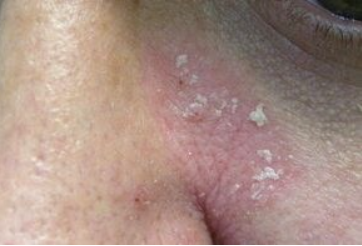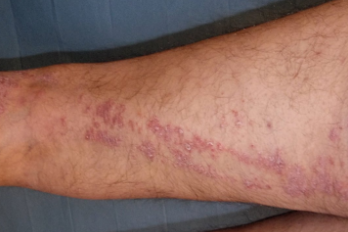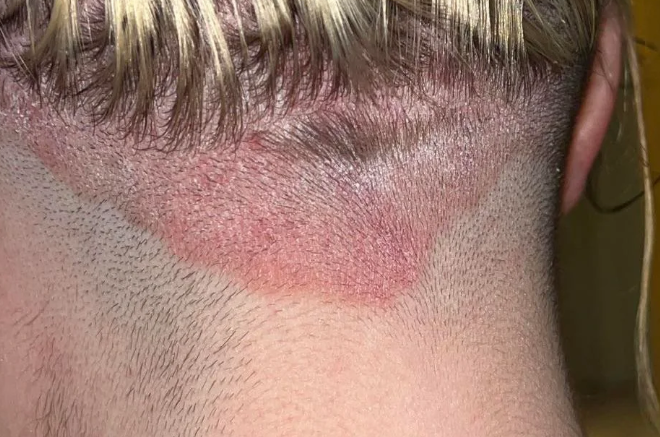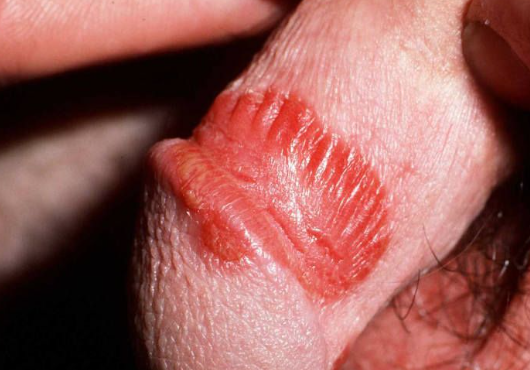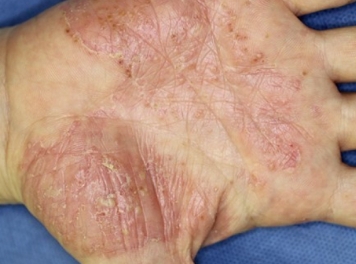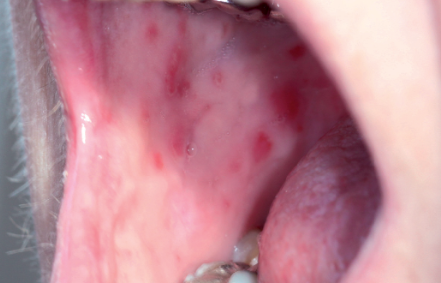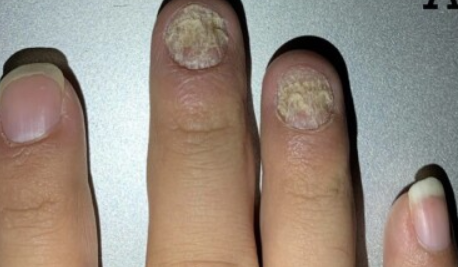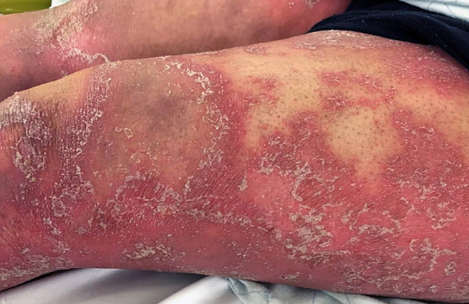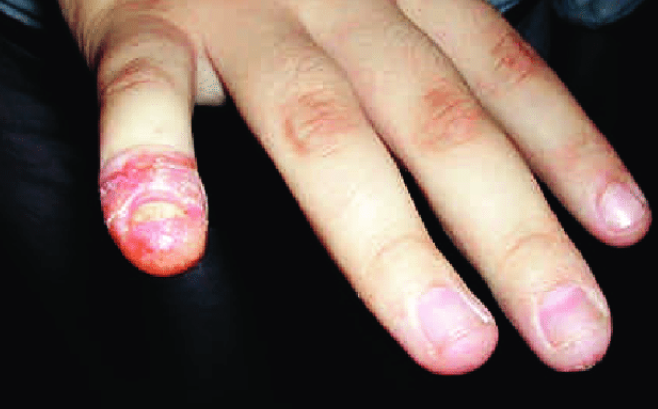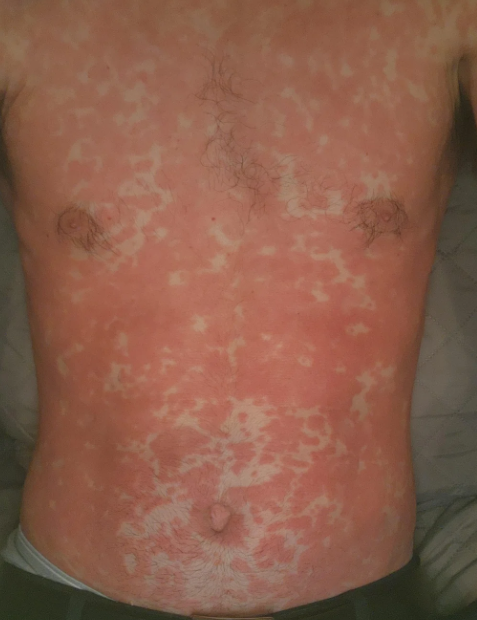Psoriasis is a common disease, occurring with approximately the same frequency as diabetes. It affects 1.5-3% of the population in Northern Europe, 1% in the United States, and accounts for an average of 6-8% of patients in dermatology clinics. Psoriasis most commonly begins at age 29 in men and 27 in women. There are two peaks of disease onset: the first is early, occurring between the ages of 16 and 22, and the second is late, occurring between the ages of 57 and 60. Early psoriasis is characterized by more severe symptoms and affects men and women equally.
Genetic predisposition, dysfunction of the immune, endocrine and nervous systems, and adverse environmental factors play an important role in the development of psoriasis.
Several genes (PSORS) have been described that predispose to the development of the disease. In particular, individuals with psoriasis are more likely to have HLACw6 and HLADR7 antigens.
Triggering factors include psychosocial stress, chronic infections (often streptococcal), alcohol abuse, use of certain medications (lithium salts, beta-blockers, chloroquine/hydroxychloroquine, oral contraceptives, interferon and its inducers, and others).
Psoriasis is often associated with systemic diseases, including metabolic syndrome, type II diabetes, ischemic heart disease, hypertension, and disorders of the hepatobiliary system.Classification:
- L40.0 Psoriasis vulgaris
- L40.1 Generalized pustular psoriasis
- L40.2 Acrodermatitis continua
- L40.3 Pustulosis palmaris et plantaris
- L40.4 Guttate psoriasis
- L40.5 Arthropathic psoriasis
- L40.8 Other psoriasis
- Inverse psoriasis
- Erythrodermic psoriasis
Course of Psoriasis
The course of psoriasis is characterized by a chronic-relapsing nature. Exacerbations and relapses of the disease occur more often in the fall and winter months (winter form) and significantly less often in the summer. The general health of people with psoriasis in its typical form remains unaffected. Untreated psoriasis can remain stable for several years.
As the disease progresses, the appearance of papules at the site of trauma or scratching (the Koebner phenomenon) is common. Newly appearing eruptions are small, but due to peripheral growth, they gradually or fairly quickly merge into plaques of various shapes (usually symmetrical, less commonly unilateral in the form of lines).
During the stationary stage, the intense peripheral growth of the eruptions ceases and the boundaries of the affected areas become more defined. With the prolonged existence of limited plaques, significant thickening may occur, sometimes with papillomatous and verrucous growths. The rash may appear on any part of the body, but initial lesions are most common on the extensor surfaces of the large joints and on the scalp.
Regressive stage: There is a resolution of the plaques as they gradually flatten, reduce scaling, and partially or completely disappear (spontaneously or as a result of treatment). Depigmented or, less commonly, hyperpigmented spots may appear in place of the resolved plaques.
Psoriasis vulgaris
Psoriasis vulgaris is characterized by the appearance of pink-red papular elements with distinct borders that tend to coalesce and form plaques of various shapes and sizes covered with silvery white scales. These plaques are most common on the scalp, the extensor surfaces of the elbows and knees, the lumbar and sacral regions, but may occur on any part of the skin.
Sebopsoriasis
Guttate Psoriasis
Follicular Psoriasis
Verrucous Psoriasis
Annular Psoriasis
Linear psoriasis
Inverse Psoriasis
Scalp Psoriasis
Genital Psoriasis
Palmoplantar Psoriasis
Oral mucosa involvement
Nail Psoriasis
Generalized Pustular Psoriasis of Zumbusch
Acrodermatitis Continua of Hallopeau
Many researchers consider it a separate disease. Provoking factors may be trauma and bacterial infections. On the skin of the distal phalanges of the fingers and toes, especially around the nail plates, flat aseptic pustular eruptions with well-defined borders develop against a background of erythema. These pustules are small (up to 0.5 cm) and may coalesce.
The pustules rupture, resulting in the formation of painful erosive surfaces, or they become covered with purulent crusts. After the affected areas are damaged, new pustular elements appear. The process becomes increasingly chronic, affecting new fingers.
Psoriatic erythroderma
It often develops as a result of exacerbation of pre-existing psoriasis vulgaris due to irritating factors. Erythroderma can develop even in a healthy person when the eruptions of rapidly progressing psoriasis merge. The process spreads to all skin surfaces, affecting more than 90% of the skin. The skin becomes bright red, edematous, infiltrated, occasionally lichenified, hot to the touch, covered with numerous large and small dry white scales that come off easily when clothing is removed.
Patients experience severe itching, sensation of skin tightness and discomfort. The general condition of the patient is disturbed: weakness, malaise, loss of appetite, increased body temperature up to 38-39°C, enlargement of lymph nodes (especially in the groin and thighs), decreased sweating. Prolonged existence of this condition may lead to hair loss and nail involvement.Psoriatic Arthritis
Joint involvement may develop with or precede psoriatic skin eruptions. Subsequently, there may be synchrony in the development of psoriatic arthritis exacerbations and skin lesions. The joint process is characterized by skin redness over the affected joints, swelling, pain, limited mobility, and morning stiffness. Joint deformities, ankylosis, enthesitis (inflammation of tendons and ligaments at their attachment to bones), dactylitis, and spondylitis may be observed.
The diagnosis of psoriasis is based on the clinical presentation of the disease, the identification of the Auspitz sign and the presence of the Koebner phenomenon in the progressive stage.
Dermatological symptoms of psoriasis
- Auspitz sign - when gently scraping the psoriatic elements, pinpoint bleeding occurs due to papillomatosis.
- Koebner Phenomenon - a sign of psoriasis: the appearance of fresh eruptions at sites of skin irritation during the progression of the disease.
- Pilnov's sign - a peripheral ring of erythema around psoriatic papules not covered by scales; characteristic of psoriasis progression.
- Pseudoatrophic ring - a sign of psoriasis in regression: a bright, shiny ring of slightly wrinkled skin is seen around the papules.
- Oil Drop Sign - the appearance of a yellowish spot in the center of the nail plate.
- Pitting sign - the appearance of small depressions on the nail plate.
Psoriasis vulgaris
- Papular syphilis
- Lichen planus
- Reiter's disease
- Large plaque parapsoriasis
- Dermatomyositis
Guttate Psoriasis
- Secondary Syphilis
- Pityriasis Rosea
- Small Plaque Parapsoriasis
- Pityriasis Lichenoides
Follicular Psoriasis
- Darier's Disease
- Kyrle's Disease
- Follicular Lichen Planus
- Pityriasis rubra pilaris
Annular Psoriasis
- Erythema annulare centrifugum
- Granuloma Annulare
Linear Psoriasis
- Lichen striatus
- Linear Lichen Planus
- Linear Epidermal Nevus
Scalp psoriasis
- Seborrheic dermatitis
- Lichen simplex chronicus
- Tinea amiantacea
Inverse psoriasis
- Candidal intertrigo
- Tinea cruris
- Hailey–Hailey disease
Genital psoriasis
- Balanitis
- Lichen planus
- Zoon's plasma cell balanitis
- Erythroplasia of Queyrat
- Bowenoid papulosis
Palmoplantar psoriasis
- Syphilis
- Keratoderma Blennorrhagica
- Eczema
- Keratoderma climactericum
- Diffuse hereditary palmoplantar keratodermas
Generalized Pustular Psoriasis
- Pustular psoriasis of pregnancy
- Dermatitis herpetiformis
Psoriatic Erythroderma
- Mycosis fungoides
- Pityriasis rubra pilaris
- Erythroderma in eczema
- Ichtyosis
- Sarcoidosis
Psoriatic Arthritis
- Rheumatoid arthritis
Treatment Goals:
- Reduce the clinical manifestations of the disease.
- To reduce the frequency of relapses.
- Alleviation of pathological subjective sensations.
- Improve the patient's quality of life.
- Reduce the risk of comorbidities.
General Remarks on Therapy
- For local form of psoriasis, topical glucocorticosteroids, products containing synthetic analogues of vitamin D, and activated zinc pyrithione are used. In addition, ointments containing salicylic acid, naphthalene oil, ichthyol and tar may be used.
- Combined therapy with glucocorticosteroids in combination with salicylic acid is prescribed for severe scaling. The addition of salicylic acid significantly increases the efficacy of topical glucocorticosteroids.
- Use of topical glucocorticosteroids in combination with other topical agents (e.g., vitamin D analogues) or systemic agents can prolong remission, even in problematic localizations.
- Vitamin D analogues may be a preferred method of treatment for psoriasis vulgaris and should not be prescribed prior to UV irradiation.
- Phototherapy is an important part of the treatment and rehabilitation of psoriasis patients. Psoriasis is treated with medium wave UV (UVB) therapy and PUVA therapy.
- Phototherapy and systemic retinoids have a synergistic effect, so combining them can improve outcomes in severe and treatment-resistant forms of psoriasis. This combination may also be used when phototherapy and retinoids used alone are insufficient or ineffective.
- For treatment of moderate to severe psoriasis, immunosuppressive agents (cyclosporine, methotrexate, acitretin) and biologics are used.
Treatment Regimens
Topical Glucocorticosteroids
Treatment with topical glucocorticoid preparations involves daily applications 1-2 times a day for 3-4 weeks. If symptoms decrease, the frequency may be reduced or other topical treatment may be prescribed.
For scalp psoriasis, clobetasol propionate 0.05% may be used in shampoo form with daily application to dry scalp for 15 minutes followed by rinsing. Long-term proactive therapy of patients with scalp psoriasis using shampoo twice a week may prevent the development of further exacerbation of the dermatosis.
- Hydrocortisone 17-butyrate, cream, ointment 0.1%,1-2 times a day for 3-4 weeks
- Alclometasone dipropionate, cream, ointment 0.05%, 1-2 times a day for 3-4 weeks
- Betamethasone dipropionate, cream, ointment 0.025%, 0.05%, 1-2 times a day for 3-4 weeks
- Betamethasone valerate, cream, ointment 0.1%, 1-2 times a day for 3-4 weeks
- Methylprednisolone aceponate, cream, ointment, emulsion 0.1%, 1-2 times a day for 3-4 weeks
- Mometasone furoate, cream, ointment, lotion 0.1%, 1-2 times a day for 3-4 weeks
- Clobetasol propionate, cream, ointment 0.05%, 1-2 times a day for 3-4 weeks
- Clobetasol propionate, shampoo 0.05%, daily application to dry scalp for 15 minutes for 3-4 weeks
Vitamin D Analogues for Psoriasis
Vitamin D analogues for psoriasis are applied to the affected skin areas twice daily for 6-8 weeks. During prolonged treatment, the daily dose should not exceed 15 grams and the weekly dose should not exceed 100 grams of cream or ointment. Repeated courses of treatment are possible during subsequent exacerbations.
The use of the combined preparation of calcipotriol and the corticosteroid betamethasone dipropionate allows faster achievement of clinical effect. Ointment form is prescribed to adults once a day for a maximum of 4 weeks. Maximum daily dose is not more than 15 grams and maximum weekly dose is 100 grams. Gel form is administered to adults once daily. Recommended duration of treatment is 4 weeks for scalp psoriasis and 8 weeks for skin lesions on other parts of the body. The product should be left on the skin overnight or throughout the day for optimal therapeutic effect.
Methotrexate
Methotrexate is used for severe forms of the disease: plaque psoriasis resistant to previous therapy, pustular psoriasis, psoriatic erythroderma, and psoriatic arthritis.
The initial dose of the drug when administered parenterally is 7.5-10 mg per week and may be increased to 30 mg per week as needed. Folic acid should be taken 5 mg 24 hours after methotrexate administration. After achieving a therapeutic effect, maintenance therapy is possible at a minimum effective dose (not exceeding 22.5 mg per week).
Acitretin
Acitretin is used for the treatment of severe forms of psoriasis, including psoriatic erythroderma, localized or generalized pustular psoriasis, and palmoplantar psoriasis.
Acitretin is recommended to be taken 1-2 times a day with food or milk. The initial dose of acitretin is 0.3-0.5 mg per kg per day and the duration of treatment is 6-8 weeks. The optimal required dose of the medication is determined based on the obtained results. Adequately dosed patients may experience slight dryness of the lips, which may serve as a clinical indicator of appropriate dosing of the medication. The duration of treatment and the dose of acitretin depend on the severity of the disease and the patient's tolerance to the medication. Maintenance therapy is not recommended.
Infliximab
Infliximab is a selective antagonist of TNF-alpha consisting of chimeric monoclonal antibodies IgG. These antibodies consist of 75% human and 25% mouse proteins. Infliximab is indicated for the treatment of adult patients with severe and moderate forms of psoriasis and progressive psoriatic arthritis.
Infliximab is administered intravenously as an infusion over a period of at least 2 hours at a maximum rate of 2 ml/minute under the supervision of medical staff. For the treatment of psoriasis and psoriatic arthritis, the initial dose of infliximab is 5 mg per kg of patient weight. After the first dose, the same dose is given every 2 weeks, then every 6 weeks, and then every 8 weeks. If there is no effect within 14 weeks (after four intravenous infusions), it is not recommended to continue treatment.
Adalimumab
Adalimumab is a selective immunosuppressive drug and consists of fully human monoclonal antibodies that block the activity of TNF-alpha, an inflammatory cytokine that plays a key role in the pathogenesis of psoriasis.
For chronic plaque psoriasis, the initial dose for adult patients is 80 mg. The maintenance dose is 40 mg administered subcutaneously in the thigh or abdomen once every 2 weeks starting one week after the initial dose.
Ustekinumab
Ustekinumab is a fully human IgG1k monoclonal antibody with high affinity and specificity for the p40 subunit of human interleukins (IL) IL-12 and IL-23. Ustekinumab is indicated for the treatment of patients 18 years of age and older with moderate to severe plaque psoriasis and patients with active psoriatic arthritis as monotherapy or in combination with methotrexate.
Ustekinumab is for subcutaneous injection. The recommended dose is 45 mg. The second injection is given 4 weeks after the first, and subsequent injections are given every 12 weeks. For patients with a body weight greater than 100 kg, a dose of 90 mg is recommended. If clinical efficacy is inadequate when the drug is administered every 12 weeks, the dose should be increased to 90 mg every 12 weeks. If this dosing regimen is not effective, the 90 mg dose of the drug should be administered every 8 weeks. Resuming treatment according to the suggested schedule with a second injection after 4 weeks of initial administration and then every 12 weeks has also been effective.
Phototherapy
Phototherapy is an important part of the treatment and rehabilitation of patients with psoriasis. Medium wave phototherapy (UVB/UVB-311) and PUVA therapy methods are used to treat psoriasis.

